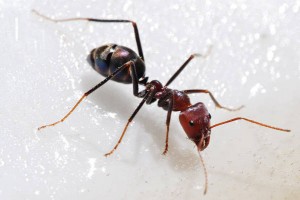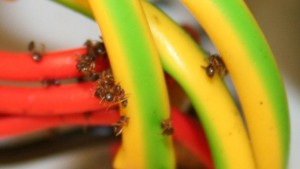PVC has been used extensively in a wide range of construction products for over half a century. PVC’s strong, lightweight, durable and versatile characteristics make it ideal for an ample range of applications. PVC has a versatility that helps it meet the various needs of modern architecture. PVC was first used as cable insulation as a replacement for rubber during the Second World War, but has now become the superior material through its flexibility, ease of handling in installation and inherent flame retardation. PVC cables do not harden and crack over time and find use in many applications from telecommunications to electric blankets. In Europe, about 25% of all flexible PVC is used in the production of wire and cables for the electrical industries.
 As resistant as PVC is to abrasion and corrosion, there is one thing that PVC has absolutely no resistance against-pests! Insects such as ants and termites have been long-standing enemies of PVC who damage and eventually destroy the articles. A number of insects including termites, like beetles, ants, wasps etc secrete formic acid that has the ability to dissolve the insulation of wires thereby destroying them. About 3% of the body weight of termites is made up of formic acid. Termites cause over $2 billion every year in property damage. And that’s not all wood! Termites do not eat plastic; however, the aggressive Formosan termite is known to attack plastic in search of food. Termites often chew through softer plastics. They play havoc with buried cables and sometimes bore a hole through water pipes causing service interruptions and major damage. Tunneling can lead to damage to electrical cords and cause blackouts.
As resistant as PVC is to abrasion and corrosion, there is one thing that PVC has absolutely no resistance against-pests! Insects such as ants and termites have been long-standing enemies of PVC who damage and eventually destroy the articles. A number of insects including termites, like beetles, ants, wasps etc secrete formic acid that has the ability to dissolve the insulation of wires thereby destroying them. About 3% of the body weight of termites is made up of formic acid. Termites cause over $2 billion every year in property damage. And that’s not all wood! Termites do not eat plastic; however, the aggressive Formosan termite is known to attack plastic in search of food. Termites often chew through softer plastics. They play havoc with buried cables and sometimes bore a hole through water pipes causing service interruptions and major damage. Tunneling can lead to damage to electrical cords and cause blackouts.
Besides termites, the other species that cause major damage to PVC articles are ants. Ants going about their daily routine grow increasingly frustrated with the presence of underground optical cables and other telecommunications equipment including lawn pedestals and terminating boxes and thereby become a growing problem for telecom companies that can blame local outages on their activities. There have been a lot of incidences where outages have been directly attributed to insect activity. Material brought into the colony can overheat equipment when it blocks air vents, increased moisture from the insects can corrode or compromise sensitive electronics, and insect attempts to push PVC wiring out of the way can ruin optical cables.
activity. Material brought into the colony can overheat equipment when it blocks air vents, increased moisture from the insects can corrode or compromise sensitive electronics, and insect attempts to push PVC wiring out of the way can ruin optical cables.
Below is an article that sheds some light on the damage caused by these critters on PVC wires and cables.
‘Crazy’ Ants, New Invasive Species, Destroys Electric Wiring, Unfazed By Conventional Pesticides
Posted: 06/10/2013
If you thought fire ants were bad, just wait until you get a load of “crazy” ants.
Yes, crazy ants, a species of South American ant whose colony movements are so erratic that researchers could only evoke insanity when describing them.
Also known as raspberry or tawny crazy ants, the insects have spread to Florida, Louisiana and Mississippi since first being spotted in Houston, Texas, in 2002. They “have a taste for everything from livestock to electrical equipment,” according to ABC News. They have been known to infest homes, transformers and even electronic devices such as laptops and smartphones.
Unlike its cousin the fire ant (also called the red ant), which it has displaced in several locations, the crazy ant is highly invasive. Moving into competitive territory, crazy ants aggressively compete for other species’ resources and establish dominance. Poison bait that works on fire ants is ineffective on crazy ants because the insects won’t take it.
“When you talk to folks who live in the invaded areas, they tell you they want their fire ants back,” Ed LeBrun, an invasive species researcher at the University of Texas, said in a UT Austin College of Natural Sciences video. “Fire ants are in many ways very polite. They live in your yard. They form mounds and stay there, and they only interact with you if you step on their mound.”
LeBrun, co-author of a recent study on how crazy ants have displaced fire ants in Texas’ ecosystems, explained that the insects’ opportunistic nesting habits are a key factor in their biological dominance. That dominance could mean drastic changes to an ecosystem that’s adjusted to the presence of fire ants — also an invasive species — over the past 40 years.
While they are omnivorous, the ants do not actually “feast on” electrical equipment, as has been suggested. The ants damage electronics by “forming bridges between the electrical contacts” and shorting them out, LeBrun pointed out.
Though the crazy ant threat to electronics has not been lost on the tech media, the insects are probably more a threat to your air conditioner than they are to your iPhone. As CNET notes, “You might want to think twice about leaving your laptop outside in crazy ant territory, but the ants are more likely to get into fixed equipment, house wiring and even recreational vehicles.”
 Although these pests have been a source of great concern and annoyance, killing them using poisons or traps somehow seems ethically wrong, not to mention unsafe and toxic. Thus we need to find a way to protect our wires and pipes from the action of these critters, without causing any harm to them or the environment. PVC has been under attack by the action of insects for decades; however we are no closer to finding a solution for this problem than we were hundreds of years ago-until recently. C Tech Corporation provides an exceptional solution for this dilemma!
Although these pests have been a source of great concern and annoyance, killing them using poisons or traps somehow seems ethically wrong, not to mention unsafe and toxic. Thus we need to find a way to protect our wires and pipes from the action of these critters, without causing any harm to them or the environment. PVC has been under attack by the action of insects for decades; however we are no closer to finding a solution for this problem than we were hundreds of years ago-until recently. C Tech Corporation provides an exceptional solution for this dilemma!
C Tech Corporation can offer a solution to overcome this problem. Our product Combirepel™ is an extremely low toxicity and extremely low hazard and eco-friendly rodent aversive. Combirepel™ is available in the form of solid masterbatches, liquid concentrate and in lacquer form. The product is compliant with RoHS, RoHS2, and REACH and is FIFRA exempted. This product acts through a series of highly developed intricate mechanism ensuring that rodents are kept away from the target application.
The fencing and tree guards can be coated with Combirepel™ to protect the trees, shrubs etc. from the damage caused by the grey squirrels. The product can also be incorporated into agricultural films, greenhouse films, plastic mulches used on a large scale in the agriculture as well as horticulture sector in order to avoid damages caused by these squirrels to fruits and vegetables. Also, the products can be directly incorporated in the polymer matrix during processing of pipes and tubing. Combirepel™ does not leach out, thus there is no soil pollution. Groundwater reserves are also not polluted. Also the non-target beneficial species like earthworms, bees etc are not affected.
The product is compliant with ROHS, ROHS2, ISO, REACH, APVMA, NEA, EU-BPR, and FIFRA exempted.
Contact us at technical.marketing@ctechcorporation.com if you’re facing problems with rodents and get best remedies to combat the pest menace.
Also, visit our websites:
http://www.ctechcorporation.com/
http://www.rodrepel.com/
http://www.termirepel.com/
http://www.combirepel.com/
Follow our Facebook pages at:
1] https://www.facebook.com/Combirepel-411710912249274/
2] https://www.facebook.com/Termirepel-104225413091251/
3] https://www.facebook.com/Rodrepel-120734974768048/
Follow us on our Twitter pages at:
1] https://twitter.com/rodrepel
2] https://twitter.com/termirepel
3] https://twitter.com/combirepel
